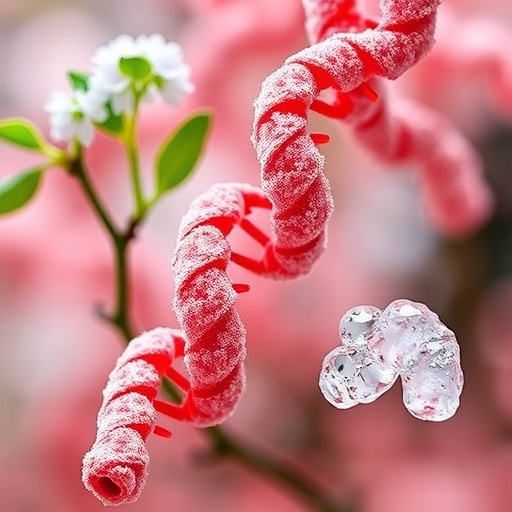
In a groundbreaking study, researchers Dariusz Jakubas, Krystyna Wojczulanis-Jakubas, and Åukasz Iliszko have shed light on the intriguing foraging behaviors of the little auk, a small seabird known scientifically as Alle alle. This comprehensive investigation explores the nuanced differences in foraging ecology between male and female little auks during the critical pre-laying period, utilizing advanced remote sensing techniques combined with innovative animal-tracking technologies. The findings provide profound insights not only into the behavior of this species but also contribute to broader ecological understandings regarding sex-specific roles in marine avian species.
The little auk, a species primarily found in the high Arctic, has garnered attention due to its unique feeding strategies that are heavily reliant on small marine invertebrates, particularly zooplankton. As climate change continues to impact marine ecosystems, understanding the foraging patterns of such species becomes increasingly important. The study by Jakubas and colleagues delves into how environmental changes might affect the foraging dynamics of these seabirds, revealing significant differences in how males and females exploit available food resources.
In their research, the authors employed advanced remote sensing methodologies alongside animal-tracking technologies that provide accurate and high-resolution data on the little auk’s movement patterns and foraging locations. This methodological approach allows for a more precise analysis of foraging success relative to environmental variables, effectively capturing the dynamics at play during the species’ critical breeding season. The research illustrates a compelling narrative of adaptation and competition, offering a window into the lives of these fascinating birds.
The study highlights that male little auks tend to forage in different areas compared to their female counterparts, with males demonstrating a preference for locations that yield higher concentrations of zooplankton. This divergence in foraging habitat reflects not only on the nutritional needs of the birds but also the potential reproductive strategies they may employ. With breeding success intimately linked to food availability, the male’s strategic foraging could be a reflection of the competitive pressures and territorial behaviors observed in the animal kingdom.
Interestingly, the research also points out that females exhibit a more varied foraging strategy, venturing into diverse habitats that might yield lower overall zooplankton densities but provide substitutes when preferred food sources are scarce. This adaptive behavior suggests that females may be optimizing foraging success during periods of changing environmental conditions, allowing for flexibility that could be essential for the survival of both the female and her offspring.
The implications of this study extend beyond the individual behaviors of the little auk. The findings prompt questions regarding the broader ecological interactions that occur within their marine environment. For instance, understanding the foraging ecology of these birds could shed light on how shifts in zooplankton populationsâoften a reflection of climate-induced changesâmight influence avian reproductive success, subsequently affecting population dynamics in these high-latitude ecosystems.
Moreover, the researchers emphasize the role of seasonal variation in foraging success, observing that the pre-laying period, which occurs just before the breeding season, is critical for both sexes. The data collected highlight that during this time, males are particularly driven to maximize their intake as a strategy to impress potential mates and ensure reproductive opportunities. In contrast, while females are also focused on foraging, their strategies reflect a dual objective of meeting personal nutritional needs and preparing for the demands of parental care once the eggs are laid.
The study portrays the little auk as a model organism for exploring ecological patterns and processes within polar marine environments. By demonstrating the intricate relationships between sex, foraging behavior, and reproductive success, the research lays the groundwork for future studies aimed at exploring how avian species might adapt to rapidly changing environments. This work calls upon researchers to deepen their understanding of sex-specific differences not just in little auks but across various wildlife populations.
In essence, this research not only enriches our understanding of the operational dynamics within the ecosystem but also highlights the crucial adaptation mechanisms birds employ in the face of ecological pressures. It advocates for a more nuanced appreciation of sexual dimorphism in foraging strategies, pushing for further investigations into how such differences may confer advantages in fluctuating environments.
Overall, the research underscores the vital importance of combining modern technology with biological studies to yield insights that were once beyond the reach of traditional observation methods. By bringing forth this innovative approach, Jakubas, Wojczulanis-Jakubas, and Iliszko contribute significantly to the broader field of zoology, revealing the remarkable adaptability of species facing the trials of climate change. The potential for future studies to leverage their findings opens an avenue for deeper exploration into the interconnectedness of life in some of the planet’s most challenging habitats.
As we move forward, the implications of this study are clear: conserving species like the little auk demands not only understanding their ecological roles but actively protecting their habitats, particularly as these birds navigate the complexities of their changing environment. In a time when the impacts of climate change are acutely felt, research like this serves not just as a scientific contribution but as a call to action for conservation measures that ensure the survival of these captivating seabirds and the ecosystems they inhabit.
Subject of Research: Foraging ecology and sex differences in little auks
Article Title: Sex differences in foraging ecology of a zooplanktivorous little auk Alle alle during the pre-laying period: insights from remote sensing and animal-tracking
Article References:
Jakubas, D., Wojczulanis-Jakubas, K. & Iliszko, L.M. Sex differences in foraging ecology of a zooplanktivorous little auk Alle alle during the pre-laying period: insights from remote sensing and animal-tracking. Front Zool 21, 12 (2024). https://doi.org/10.1186/s12983-024-00534-2
Image Credits: AI Generated
DOI: 10.1186/s12983-024-00534-2
Keywords: Sex differences, foraging ecology, little auk, remote sensing, animal tracking, climate change, reproductive success.
Tags: advanced methodologies in ecological studiesanimal tracking technologies in ornithologyclimate change impact on marine birdsecological roles of male and female seabirdsgender differences in seabird behaviorhigh Arctic seabird feeding patternslittle auk foraging strategiesmarine ecosystem adaptationspre-laying period foraging behaviorsremote sensing in wildlife researchsex-specific foraging ecologyzooplankton as a food source for birds




